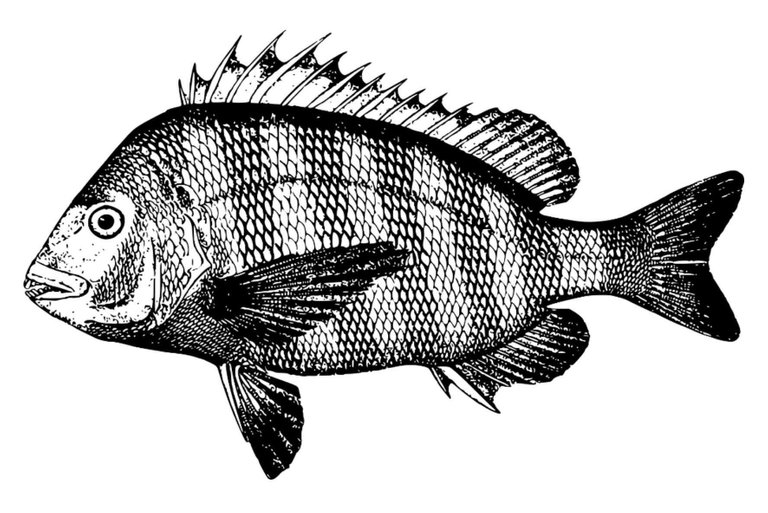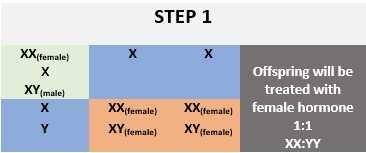Gone are the days when man solely depends on getting all his foods from the wild. Man has learned to plant his crops and even domesticate animals. Another area of advancement in the history of man is Aquaculture. Man no longer rely only on the natural waters to provide him with food; he now manipulates the waters and the living things in them to obtain their useful products. Aquaculture as a human practice started on a very small scale and it is believed to have started a very long time ago. Aquaculture may have been limited to a confinement to hold fish prior to the time they are sold but modern day aquaculture transcends that. There are several advances which range from improved knowledge of nutrition, water quality, breeding, and biotechnology. This article attempts to explain an aspect of an advancement in fish breeding which is monosex fish production.

In an attempt to stop this problem of overproduction, fish farmers will prefer to stock only the male tilapia instead. Male tends to grow faster and also bigger than their female counterparts. Well, that’s because this fish exhibits what is known as sexual dimorphism. In other words, this term means that there are notable differences between the male and female population of a species such as colour, body shape, size, etc. In the case of tilapia, the males grow larger than the female. The reason for this is not farfetched. Female fish converts most of the energy they could have used for growth for reproduction purposes. Fish expert may be able to separate the fish by their sexes by checking for differences in their sexual organs. The males are selected for culture while the females are kept aside. But this process is very tedious and time-consuming and even the experts can make the mistake in identifying their sexes at that very early stage. This would make the work futile and a complete waste of time and energy.
Another method of obtaining all-male population is through hybridization. This process involves breeding fish that are not of the same species. Previous experiments have reported success in crossing the Nile tilapia, Oreochromis niloticus and Blue tilapia, Oreochromis honorum. The offspring of the cross are predominantly male and similar results have been obtained from crosses of some other tilapia species too. This method does not always produce 100% male population, another alternative is to treat the fish at their early stage with the hormone. Tilapia fish have an early stage known as totipotent. In this early stage, their sex is not yet differentiated into male or female. The body of the fish at this stage have an almost equal amount of the female and male hormones. Introducing additional hormone from an external source such as through their feeds can influence the phenotype that will be expressed by the fish. Hormones that can influence male phenotype are known as androgen while the female hormone is known as estrogens. Treating the fish with a male hormone will alter the phenotype of the resulting population although this does not change the genotype of the fish.
Another important method of producing all-male tilapia population is the YY super male technology. For the purpose of this post, I will dwell much on this than the other methods I have mentioned. I assume you may be familiar with the sex chromosomes known as the X and Y chromosomes. The Y chromosomes in human determine whether one will be a male of a female. The absence of it means an XX chromosome and will produce a female and its presence will determine the chromosome XY which will produce a male instead. Not only humans have this sex chromosome, but it is also present in other animals too. Some have others different from the X and Y like the Z and W chromosomes. A male human is said to have XY chromosome while a female is said to have XX chromosome. This is similar to what you get in the tilapia species of aquaculture. The female has an XX chromosome while the female has an XY chromosome. The production of “Super males” manipulates this normal process to obtain YY chromosome male.
To help you understand why this “Super males” are important, I will start by explaining the normal crossing patterns and the possible outcomes from such. In a normal crossing between a male (XY) and female (XX), the possible genotype for the offspring is either XX or XY. That is, either a female offspring or a male offspring will be obtained. But in a cross between a “Supermale” (YY) and any female (XX), the only genotype you can get will be the XY genotype. That is, all the offspring from such crosses results in all-male population. If you remember that I earlier stated that the goal of the fish farmer is to obtain the maximum size of fish in the shortest possible time which is obtainable by producing an all-male population.
PRODUCTION OF YY “SUPER MALE”
The production of YY “Supermale” is very important to the success of this process but it is not the end product itself. It will be used as parent fish to cross any XX female thereby producing all-male seeds. Production of YY “super male” starts with the feminization of the XY tilapia. The first step involves the crossing of normal XY male and XX female. The offspring obtained from this process will XX and XY in the ratio of 1:1.they are treated with estrogen, the female hormone, to produce all female offspring. Remember that the hormone doesn’t change their genotype but just influence their gonadal development to be that of a female. This will cause a sex reversal for the XY fish turning them to XY females.
The next stage is the identification of the XY female that has been sex-reversed and crossing such with a normal XY male. The possible outcomes from this cross are the XX, XY, and YY. At this stage, the first YY “super male” has been obtained but there is a need for the process to continue to obtain more pure lines of this YY males.
The identified YY males are further crossed with the XY sex-reversed female obtained before to produce XY and YY males in the ratio of 1:1. These offspring are then further treated with the female hormones to obtain YY females this time. The YY females and YY males are then crossed as the last stage of this process to obtain pure YY male lines. These YY males will be the parent fish that will be used to produce all male tilapia fish whenever there is a production.
IDENTIFICATION OF SEX REVERSED FISH
One of the major challenges with the production of the super male is the identification of the sex-reversed fish. They do not show any obvious difference from the other fish. It can take some time to confirm the true status of their genotypes. One of the main method used to confirm their status is through progeny testing. Fishes obtained from crosses are isolated and crossed with fishes whose genotypes are known. This method can be used to confirm the genotype of the test fish. Another methods described by Alcantar-Vazques et al. that has proven successful it to use fish that previously were discarded because they thought they lack functioning female gonads. These fish are referred to as atypical fish. They may have male external organ but are still able to produce eggs. A test stripping of this fish will confirm the presence of eggs.
All images used without reference were designed by me for further illustration.




Reference and further reading
- Rahman, A.R.M et al. (2013). Interspecific hybridization and Its potential for Aquaculture of Fin Fishes. DOI: 10.3923/ajava.2013.139.153
- Francis, N.O. and Esa, Y.B. (2016). A review of the production protocols used in producing economically viable monosex tilapia. DOI: 10.3923/jfas.2016.1.11
- Carlos, F. et al. (2012). Male tilapia production techniques: A mini review. DOI: 10.5897/AJB11.4119
- Alcantar-Vazques, J.P. et al (2014). Production of YY –male of Nile tilapia Oreochromis niloticus (Linnaeus, 1758). DOI: 103856/vol42-issue3-fulltext-21
- Beardmore, J.A. et al. (2001). Monosex male production in finfish as exemplified by tilapia: applications, problems, and prospects.
Hello! I find your post valuable for the wafrica community! Thanks for the great post! We encourage and support quality contents and projects from the West African region.
Do you have a suggestion, concern or want to appear as a guest author on WAfrica, join our discord server and discuss with a member of our curation team.
Don't forget to join us every Sunday by 20:30GMT for our Sunday WAFRO party on our discord channel. Thank you.
This post has been voted on by the SteemSTEM curation team and voting trail in collaboration with @curie.
If you appreciate the work we are doing then consider voting both projects for witness by selecting stem.witness and curie!
For additional information please join us on the SteemSTEM discord and to get to know the rest of the community!